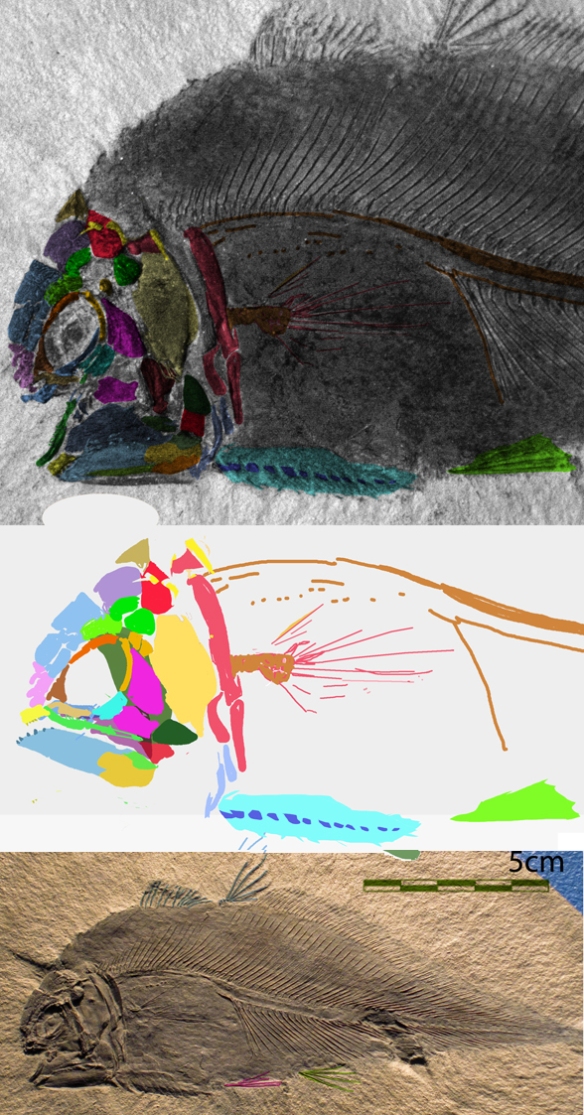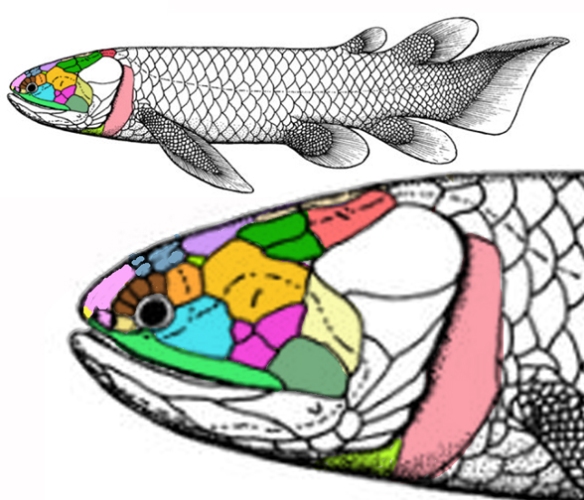Traditioinally there are four types of lobefin fish:
- Actinista = coelocanths (e.g. Latimeria, Fig. 1)
- Dipnoi = lungfish (e.g. Polypterus, Fig. 1)
- Osteolepiformes = stem tetrapods (e.g. Osteolepis, Fig. 1)
- Porolepiformes = all extinct (e.g. Porolepis, Fig. 1)

Figure 1. Lobefin fish clades in this subset of the LRT.
A fifth clade of lobefin fish
was recovered by the large reptile tree (LRT, 1787+ taxa, subset Fig. 1). The Stensioella + Guiyu clade does not nest with placoderms, as other workers posit. Those workers consider Stensioella ‘enigmatic’ and ‘with arcane affinity’. In the LRT Stensioella does not nest with coelochanthiformes either, but with Youngolepis, Guiyu and other flattened big-flipper fish, most of which do not preserve post-crania.
Getting back to Porolepiformes…
This clade starts with a Carboniferous late survivor of a Silurian radiation, Allenypterus (Fig. 2). This odd sort of ‘traditional coelocanth’ had a straight, eel-like tail, a tall, narrow torso and lobe pectoral fins only.

Figure 2. Allenypterus nests with the coelacanth lobefins in the LRT and elsewhere.
Quebecius
(Fig. 3) had lobe-fin pectoral fins, but all other fins were ray fins. The body was rounder in cross-section and the eyes were relatively smaller. Marginal teeth were tiny on longer jaws.

Figure 3. Quebecius is similar in most respects to Diplacanthus. The pectoral fin still has a pointed appearance, but the other fins have more typical rays.
Holoptychius serrulatus
(Agassiz 1839, Cope 1897; Middle Devonian to Carboniferous, 50cm to 2.5m long, Fig. 4) had lobe-fins only. The anterior skull + body was rounder in cross-section and the eyes were relatively smaller. This genus is found in marine sandstone. Tiny teeth lined the jaws, but are rarely illustrated due to their minuscule size. Large fangs descend from the palate and rise from the coronoids.

Figure 4. Holoptychius is a basal lobefin in the coelacanth clade.
Porolepis posnaniensis
(Kade 1858, named by Woodward 1891; Early Devonian, Fig. 5) apparently had a post-crania similar to Holoptychius. They eyes continued their decline in size. Colors are tetrapod homologs often different than labels. The upper squamosal is here the postorbital.

Figure 5. Holoptychius and Porolepis skulls compared.
Laccognathus panderi
(Gross 1941,Vorobyeva 2006, Down et al. 2011; Middle to Late Devonian, 390-360mya, Figs. 5, 6) was a marine costal or lagoon bottom dweller with an even wider skull, even smaller eyes and large palatal and coronoid fangs. The two external nares are confluent. Post-crania is largely unknown.

Figure 6. Laccognathus diagram from Downs et al. 2011. Colors and tetrapod homolog labels added.

Figure 7. Laccognathus specimen in situ from Downs et al. 2011. Colors added.
According to Wikipedia
“Porolepiformes was established by the Swedish paleontologist Erik Jarvik (1980), and were thought to have given rise to the salamanders and caecilians independently of the other tetrapods. He based this conclusion on the shapes of the snouts of the aforementioned groups. This view is no longer in favour in Paleontology (Schultz and Trueb 1991).”
“Jarvik also claimed the existence of choanae in porolepiformes which linked them to tetrapods, but this has remained controversial. (Clement 2001). Recent phylogenetic reconstruction places porolepiformes close to lungfishes (Janvier 1996).”
In the LRT
porolepiformes are closer to coelacanths, catfish and placoderms. Lungfish are closer to tetrapods. Choanae are not present in porolepiformes (Clement 2001).
References
Ahlberg PE1991. A re-examination of sarcopterygian interrelationships, with special reference to the Porolepiformes.
–Zoological Journal of the Linnean Society: Vol. 103, #3, pp. 241-287 [doi: 10.1111/j.1096-3642.1991.tb00905.x]
Clement G 2001. Evidence for lack of choanae in the Porolepiformes. Journal of Vertebrate Paleontology, 21: 795–802.
Downs J, Daeschler E, Jenkins F Jr and Shubin N 2011. A New Species of Laccognathus(Sarcopterygii, Porolepiformes) from the Late Devonian of Ellesmere Island, Nunavut, Canada. Journal of Vertebrate Paleontology. 31 (5): 981–996.|
Janvier P 1996. Early vertebrates. Oxford science publications. 1996, Oxford, New York: Clarendon Press; Oxford University Press.|
Jarvik E 1980. Basic structure and evolution of vertebrates. Vol. 1-2. Academic Press (London).
Schultze H-P and Trueb L1991. Origins of the higher groups of tetrapods: controversy and consensus. Cornell University Press. p. 37.
Vorobyeva EI 2006. A new species of Laccognathus (Porolepiform Crossopterygii) from the Devonian of Latvia. Paleontol. J. Physorg.com. 40 (3): 312–322. doi:10.1134/S0031030106030129.
Woodward AS 1891. Catalogue of the Fossil Fishes in the British Museum (Natural History). Part II. Catalogue of the Fossil Fishes in the British Museum (Natural History) 2.
wiki/Porolepiformes
wiki/Porolepis
wiki/Holoptychus
wiki/Allenypterus
wiki/Quebecius
wiki/Actinistia
wiki/Coelocanth
